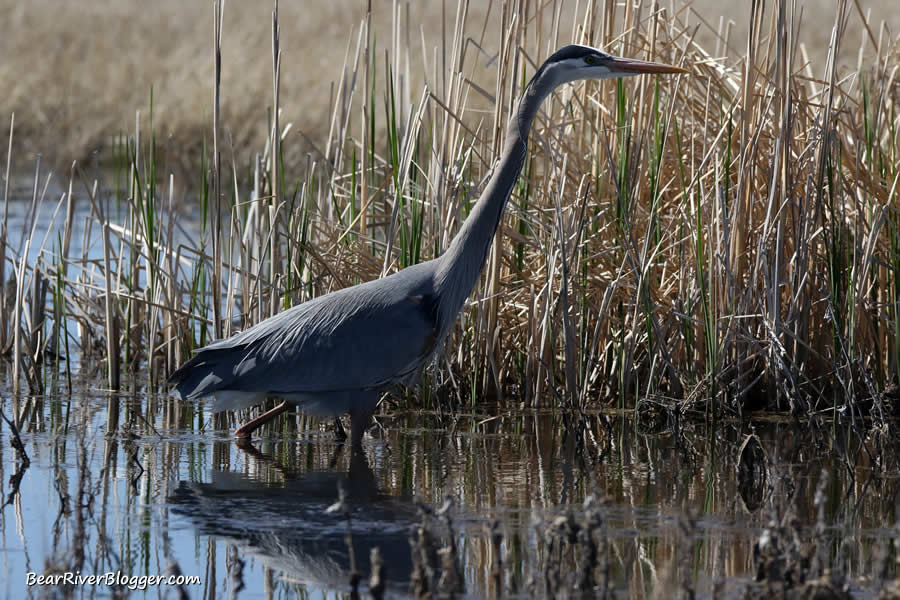I’m not sure of its origin but there’s an age-old adage out there that simply states “Birds of a feather flock together”.
But for some reason that proverb doesn’t always hold true to form, at least in the case when it comes to nesting great blue herons, that is.
There’s an interesting situation behind this particular blog post regarding that adage so let me try and explain.
It’s the start of another great blue heron breeding season and the newly revamped and expanded heron rookery at Farmington Bay is active again with nesting herons, a lot of herons if the truth was told.
During a visit to the Eccles Wildlife Education Center last week I was informed by Haley Pace with the Utah Division of Wildlife Resources that 33 of the 36 nesting platforms are in fact currently being used by pairs of great blue herons.
And from my quick walk around the nature trail west of the rookery, I could easily hear a few heron chicks had already hatched.
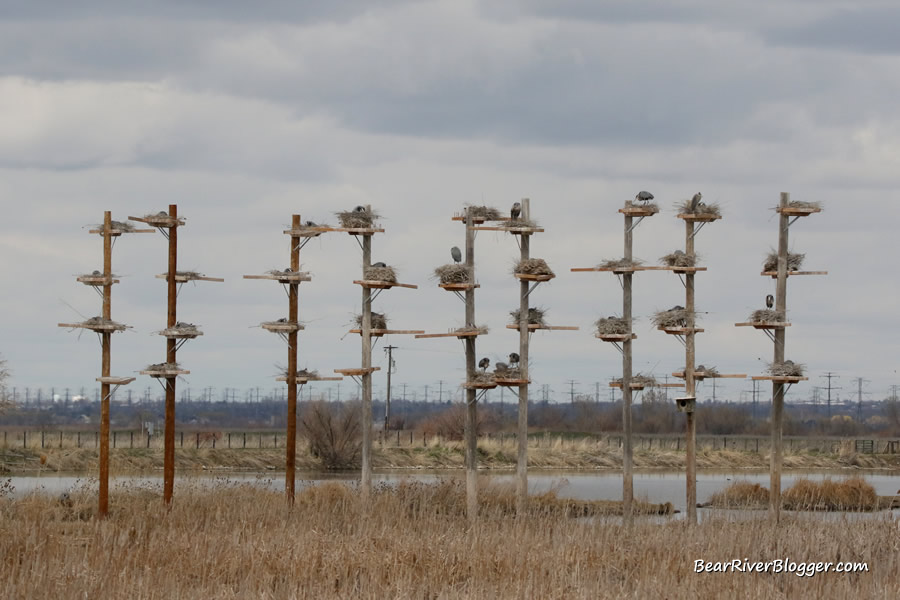
I don’t know about anybody else but I would most definitely call that a very successful wildlife conservation project with the expanded rookery near full capacity during its first year of operation.
The recent renovation expanded and doubled the rookery nesting capacity from 18 to 36 nesting platforms, all brand new and enlarged structures to hopefully attract more herons to the nesting site and away from other so-called “unwanted” locations.
And by the term “unwanted locations” I am specifically referring to in this case the large power transmission lines owned and operated by Rocky Mountain Power that cross the east boundary of Farmington Bay.
In years past, great blue herons were nesting high up on a few of these large man-made structures and subsequently causing issues with their nesting material and droppings so it was proposed to expand and update the rookery at the Eccles Wildlife Education Center in hopes of attracting the herons away from these electrical power poles and back to the wetlands where they belong.
But, unfortunately, even though the expanded great blue heron rookery has attracted nearly double the nesting pairs of herons to the structure this spring, a drive along the main entrance to Farmington Bay last week showed there are at least 4 nesting pairs of great blue herons still actively trying to build nests on the large power poles.
I sat and watched several great blue herons carry sticks back to their chosen but forbidden nesting sites, taking a few moments to circle and gain enough attitude to reach the tops of the massive power poles.
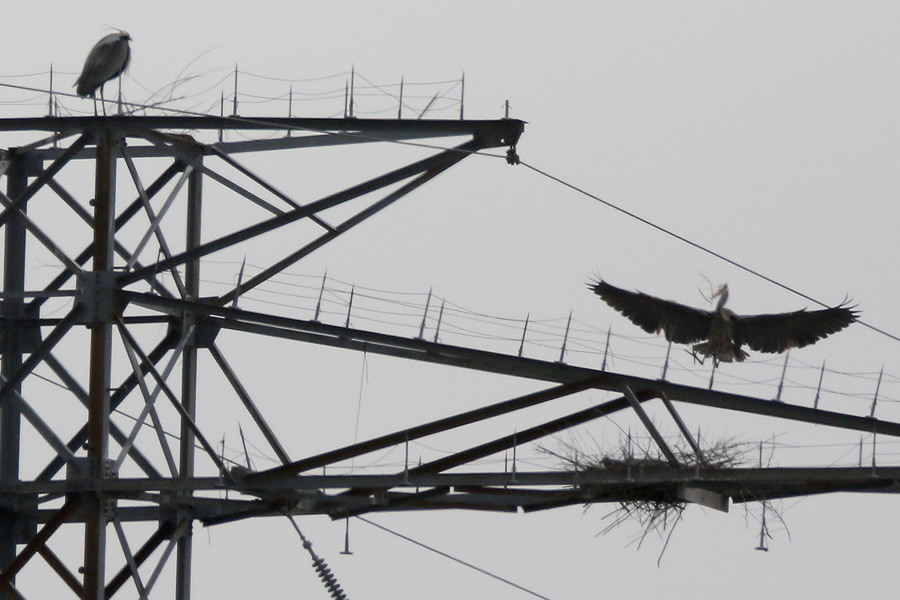
Great blue herons nest in colonies and prefer to nest in trees or other places up high and well above the ground, keeping their young out of reach from land-based predators such as skunks, foxes, raccoons, and coyotes.
The heron rookery at Farmington Bay has offered great blue herons a safe place to nest for decades since it was initially erected many years ago and maybe this success is also what’s driving the nesting problems high atop the nearby power transmission lines.
It’s kind of an interesting situation any way you slice it, more rookery nests produce more heron chicks which translate into more adult herons the following year in search of nesting sites.
It’s a simple analogy but the rookery’s success, in turn, is quite possibly a partial factor leading to great blue herons nesting in unwanted places, such as power poles and artificial Canada goose nesting platforms, both places great blue herons do indeed utilize as nests at Farmington Bay each year.
In the end, this is a testament that no matter what we do to try and “manage” nature, man’s efforts can only go so far as birds will be birds and they will ultimately do what birds want to do.
It’s kind of a self-perpetuating problem in my opinion but one with no clear-cut answer or solution.
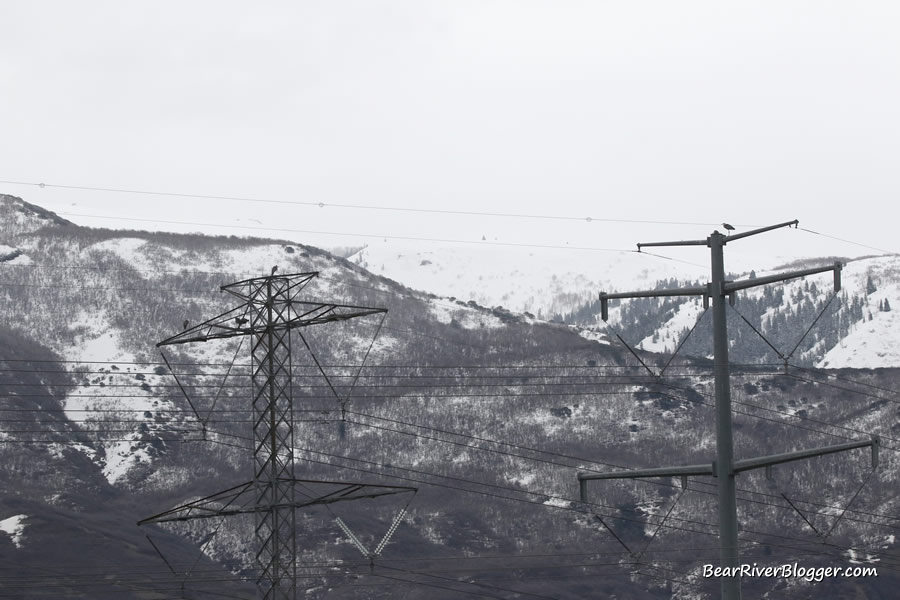
Taking the rookery away, something I would never want to happen, would most definitely add to the problem with possibly far more great blue herons around now because of the rookery’s ongoing success and the temptation to nest on the power poles being that much greater as a result.
But adding even more nests on the platform or a second nearby rookery would most likely only keep adding to the heron population, which over time will also put pressure on herons attempting to nest on unwanted structures such as these nearby power transmission lines.
With how adaptive great blue herons are at finding and eating a large variety of food year-round, it seems to me suitable and safe nesting sites are the biggest limiting factor for great blue heron populations, at least in our neck of the woods that is.
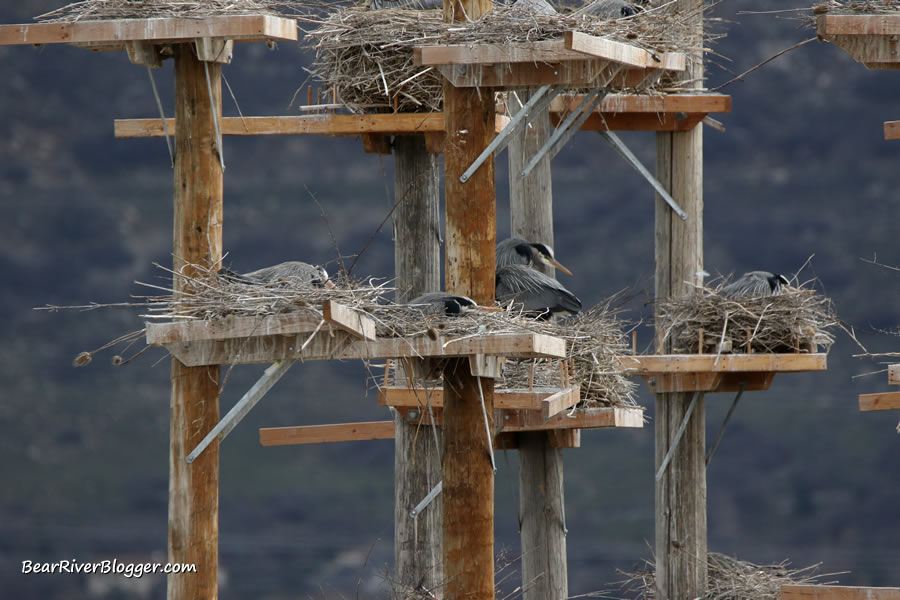
And I’m certain the heron rookery at Farmington Bay is far more productive than anywhere else on any of the Great Salt Lake wetlands since very few, if any, other “safe” nesting sites other than the artificial Canada goose platforms exist, meaning the herons would be forced to nest somewhere on the ground.
But is the rookery’s success part of the problem or part of the solution?
Or is it maybe somehow part of both?
I don’t know but interestingly enough, while I was at the Eccles Wildlife Education Center there was, however, mention of Rocky Mountain Power possibly erecting a new great blue heron rookery further down the Great Salt Lake shoreline in Layton on the Nature Conservancy property to help try and pull some great blue herons away from Farmington Bay.

Personally, I would love to see more great blue heron rookeries along the Great Salt Lake where the public could come and enjoy these incredible birds during nesting season, especially up on the Bear River Migratory Bird Refuge in Box Elder County, but I don’t think building more of these highly successful nesting structures so close to urban life in Davis County would do anything but keep adding to the conflicts between man and nature in this manner.
When we keep taking away and altering wildlife habitats, birds and other creatures will respond however they can in order to survive, including using man-made structures for nesting sites when needed.
This means a lot more conflicts between man and nature are certainly on tap for the future as wildlife habitats are continually encroached upon and lost each year.
(Great Blue Heron Rookery at Farmington Bay. For short nature clips like this one and interesting stories about the natural world around us, check out our Bear River Blogger channel on YouTube for videos and updates from our travels while out in nature.)
With regards to the great blue herons nesting on the power transmission lines, you and I don’t necessarily see the actual problem with the herons nesting on such structures as the electricity continues to flow but the men and women that work to provide us that electricity have to deal with them on a very regular basis to make sure there are no unwanted interruptions for you and I or safety concerns for their personnel that service these structures.
At the end of the day, I am glad we have protected places such as Farmington Bay so close to home where we can go and enjoy nature, especially birdwatching, in such close proximity to our homes and urban life.
But there are always inherent problems, some minor and others a bit more serious, when nature and civilization cross paths with one another.
If you love nature and birds like I do, I offer you to head on over to our subscribe page and sign up for email notifications for future blog posts like this one.
We also appreciate our readers and followers who help support and grow this website by sharing some of their favorite posts on their favorite social media outlets.
